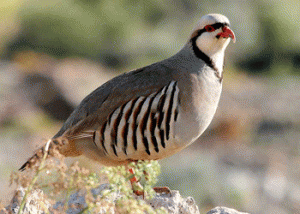How is a half wing useful? This problem has divided the scientific community on the evolution of flight since the time of Darwin because it questions the evolutionary benefit of limbs that are incapable of flight. Bird ancestors clearly did not grow fully functional wings overnight and it is still unclear exactly how wings evolved. The two main theories that have arisen are the arboreal theory and the cursorial theory, each trying to explain the origin of flight using different models. The arboreal theory hypothesizes that bird ancestors climbed tall trees or cliffs and then glided down, while the cursorial theory hypothesizes that, due to the similarity between bird and dinosaur skeletons, bird ancestors ran along the ground and eventually took off by beating their feathered forelimbs. However, Professor Ken Dial believes he has found a link between the two theories by comparing a “half wing” to that of a chukar partridge hatchling’s wings.
The half wing is considered to be an intermediate stage of flight evolution in which the forelimbs were beginning to develop into wings, but were still incapable of flight. As Dial discovered, this half wing can be used in assisting the animal when running up steep inclines. When researching how chukar partridges learn to fly vertically and horizontally, he found that they had a tendency to “cheat” and use a combination of their claws and wings to climb the vertical surfaces. Essentially, they used their wings like spoilers on a racecar in order to increase traction and climb. These underdeveloped wings of the chukar can be compared to that of the half wing because the half wings found in the fossil records share a similar skeletal form with that of a juvenile chukar.
The chukar partridge is a unique bird because it is a galliforme. Galliformes make up a very small fraction of bird species, consisting of about 214 different species, compared to song birds that have roughly 4000 different species. Galliformes are generally considered less evolved because they lack the high level of parental care that songbirds have. Instead of being nurtured in a nest as soon as they have hatched, they have to fend for themselves. Galliformes have heavier bodies, are able to walk as soon as they hatch, and spend most of their time on the ground, despite the fact that they are capable of flight. As Dial realized, the chukar partridge actually prefers to climb while assisting its ascent using its wings versus flying up to a perch, which sounds absurd because why would the bird not just fly up? By implanting sensors in a bird’s flight muscles, Dial found that running used less than 10% of the energy required for flight. This shows that it is actually beneficial for the bird to run up inclines instead of flying up.
Dial’s hypothesis and research bring both the arboreal theory and cursorial theory together by demonstrating that the evolution of flight may have involved as a combination of running and gliding. His research shows that the wing angle that the birds utilize to run up steep inclines is constant with the angle required to glide down as well as the angle required for flight. This means that bird ancestors may have run up trees with the help of their half wings in order to escape predators and then used their half wings again to guide them safely to the ground. As Kevin Padian of the University of California, Berklee put it, “[birds] are always going ‘up and forward’ in some sense”. Modern birds have learned how to utilize the most effective angle of attack such that they are able to generate lift and thrust in order to both fly and climb, pointing to a possible convergence of the two theories of evolution like Dial suggests.
Sources:
1) How A New Theory Of Bird Evolution Came About, ScienceDaily, March 3, 2009
2) Galliformes, Earthlife
3) Wing Angle May be Key to Bird Flight Origins, National Geographic News, January 23, 2008
4) Evolution of Flight: Did Early Birds Run and Flap Before They Flew?, Discover Magazine, June 24, 2011

